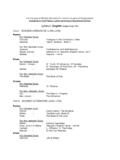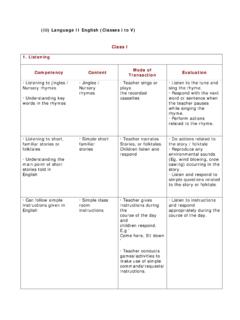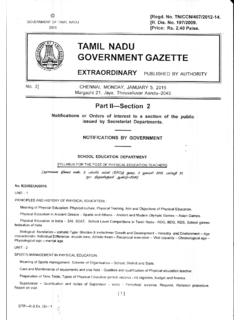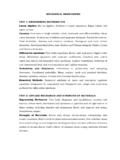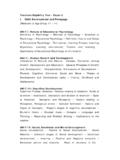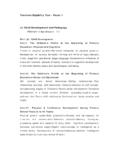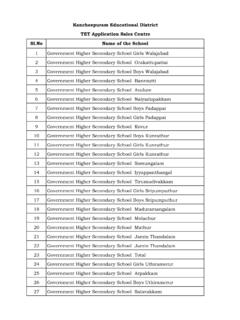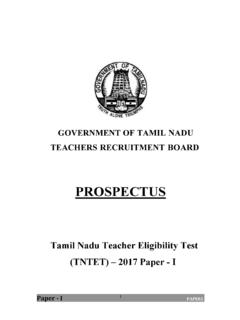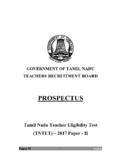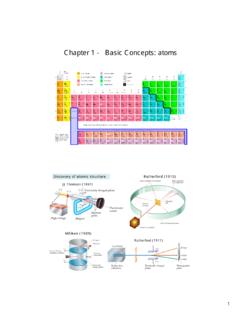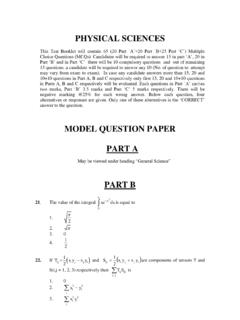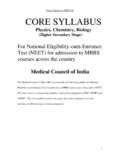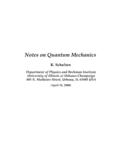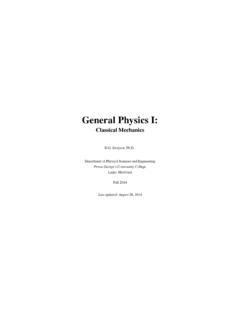Transcription of PG- 4 PHYSICS
1 For the post of Written Recruitment Test for the post of Postgraduate Assistants in Tamil Nadu Higher Secondary Educational Service. Syllabus: PHYSICS (Subject Code: P04). UNIT- I - Vector Fields General expression for gradient, divergence curl and Laplace operators in orthogonal curvilinear Co-ordinates and their explicit form in Cartesion spherical-co-ordinates, Stokes theorem and Gauss theorem. Matrix theory Algebraic operation Rank of a matrix. Eigen values and Eigen vectors - characteristic equation . Cayely Hamilton theorem Diagonalisation and Diagonalizability of unitary orthogonal.
2 Hermitian and symmetric matrices. Special functions Legendre, Hermite and Lagune equation basic properties Gamma and Beta functions. UNIT-II - Probability and Theory of errors Basic concept of probability distribution Exclusive events and addition Compound events and products Binomial Poisson and Guassian distribution Normal distribution of error Standard error . Principle of least squares Application of solution of linear equation Curve fitting. Group theory Definition Sub-groups Homomorphism and isomorphism Group representations.
3 Irreducible representation Unitary representation. UNIT III - Classical mechanics Generalised co-ordinates D'Alembert's principle, Lagrangian equation of motion Hamiltonian equation Conservative and non-conservative systems - Hamilton equation, cyclic variables, principle of least action Theory of small oscillations Normal co-ordinates and normal modes - Linear Triatomi molecule - Rigid bodies -Moments and products of inertia-Euler's angle - Euler's equation of motion- Symmetric top. UNIT-IV - Statistical Mechanics Maxwell Boltzmann statistics Maxwellian distribution of velocities Mean root mean square and most probable velocities Bose-Einstein statistics Distribution function Phonon gas Black body radiation Fermy-Dirac statistics Distribution function Electron gas Pauli paramagnetism.
4 Thermionic emission Elementary idea of phase transition Properties of liquid Helium phase space, Liouville's theorem statistical equation micro canonical ensembles Equation of state- thermodynamic functions of an ideal gas equipartition of energy. UNIT-V - Electromagnetic theory Coulomb law Gauss law Poisson's equation Laplace equation and solution to boundry value problem Electrostatics of dielectric media Molecular polarisability and its application Vector . Scalar potential B and H in a magnetic material Maxwell's equations and their significance.
5 Poynting theorem Radiation of oscillating dipole. Relativistic Mechanics Basic ideas - Lorentz transformation. Time dilation and Lorentz contraction -Velocity addition law - momentum and energy in relativistic Mechanics - Centre of mass system for two relativistic particles. UNIT-VI - Spectroscopy Rotation spectra Vibration spectra Rotation vibration spectra of diatomic and linear molecules Raman Spectra experimental techniques and classical theory of Raman Scattering Electronic state of diatomic molecules Frank Condon principle Hund's coupling scheme Evaluation of molecular constant from vibrational spectra data.
6 Interaction between nuclear spin and magnetic field Nuclear resonance-Chemical shift-Dipole-Dipole interaction-Spin lattice interaction. UNIT-VII - Solid State PHYSICS Energy levels and density of states in one, two and three dimensions Electrical and Thermal conductivities Wiedmann-Franz law. Energy bands in solids Transport phenomena in semiconductors operational functions of a junction diode-Schottky diode Bloch theorem - Krong-Penny mudel . Brillouin zones Wave equation of an electron in a periodic potential. Thermal Properties of solids Laws of Thermodynamics Maxwell's relations and their applications Phase transitions.
7 Production and measurement of low temperatures Einstein and Debye theory of specific heats of solids. Magnetic properties of materials Langevin's theory of dia-para-magnetism Quantum theory of para magnetism Ferro . magnetism Ferri magnetism superconductivity Meissner effect Thermodynamics of superconducting materials London equation theory Josephson's effect. UNIT-VIII - Quantum mechanics Schrodinger's wave equation Free particle Particle in a potential well and barrier penetration - The probability interpretation Expectation value Eigen functions and eigen values Stationery states Wave packet Uncertainty principle Linear Harmonic oscillator angular momentum and addition of angular momenta.
8 Peturbation theory Transition probability Constant and harmonic perturbation Scattering theory Differential and total scattering cross section Born approximation Partial wave analysis and phase shift analysis Relativistic wave equations Klein Gordon equations Dirac equation and its free particle solution. UNIT-IX - Nuclear PHYSICS Binding energy Semi empirical mass formula Stability of nuclei Nuclear forces Ground state of deuteron Alpha decay B decay Fermi's theory Selection rules Liquid drop model . Nuclear fission Shell model Collective models.
9 Nuclear Instrumentation Cyclotron - Synchro cyclotron Proton synchrotron Detectors Scintillation Counter Bubble chamber Nuclear reactors Neutron cross section Fission product Energy release Chain reaction Multiplication factor Moderator Natural Uranium Diffusion equation. Unit X - Electronics (Digital electronics). Binary - Decimal Octal and Hexadecimal numbers 8421 Excess 3 - Gray Codes Logic gates Laws Boolean algebra Half and full adders Subtractors RS, RST, JK and M/S Flip-flops Ripple counter Decade counter Up-down counter Serial and parallel registers.
10 Operational amplifier Differential amplifier Parameters Applications Analog integration and differentiation . Analog computation Comparators Sample and hold circuits Oscillator Hartley-Colpitt-Phase Shift - Wien's bridge oscillators Astable mono -Bistable multivibrators Clipping and clamping circuits. Microwave PHYSICS Microwave generation Klystron Magnetron Travelling wave tubes Microwave in rectangular and cylindrical wave guides Characteristics of Antennas Short dipole radiation Antenna gain Directivity Radiation resistance Radiation intensity.
